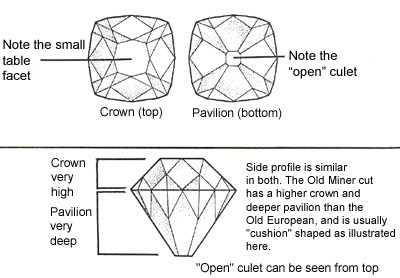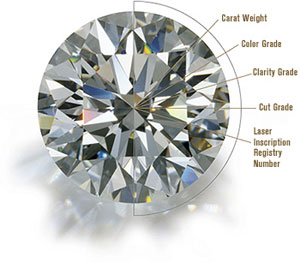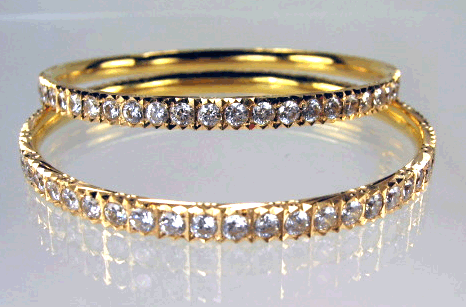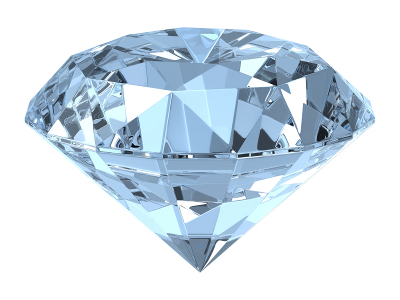The european cut, or old european cut has hand faceting features and an open culet.
Where the Old Miner Cut was an antecedent of the modern round brilliant, the Old European Cut was the direct forefather to the modern round brilliant. It was the Old European Cut that was studied for the development of the proportions that would allow the creation of the measurements for the ideal cut diamond. Rounder in shape than the Old Miner Cut, and cut with a circular girdle, the Old European Cut is similar to, but still far from its direct descendent, the round brilliant.
 Like the Old Miner Cut, the Old European cut is a rounded, hand faceted cut of diamond. The Old European, as with its direct descendent, the round brilliant, is cut with 58 facets in an effort to maximize brilliance and fire. However, it was developed before the perfection of the diamond saw, and so was primarily hand faceted. This lead to the Old European Cut being cut and polished with a small table, high crown, deep pavilion and an open culet. The deep, faceted pavilion and small table in the Old European cut is designed to bring light in, and reflect its inner fire of color back to the viewer’s eye when looking down upon the table.
Like the Old Miner Cut, the Old European cut is a rounded, hand faceted cut of diamond. The Old European, as with its direct descendent, the round brilliant, is cut with 58 facets in an effort to maximize brilliance and fire. However, it was developed before the perfection of the diamond saw, and so was primarily hand faceted. This lead to the Old European Cut being cut and polished with a small table, high crown, deep pavilion and an open culet. The deep, faceted pavilion and small table in the Old European cut is designed to bring light in, and reflect its inner fire of color back to the viewer’s eye when looking down upon the table.
It is important to note that candlelight and gaslight were the main sources of lighting for gemstones prior to the early 20th century. Each of these is much dimmer, and far more forgiving of flaws, than modern electric lighting. Under the softer lighting of the 19th century the hand faceting, deep pavilion, open culet and small table resulted in a scintillation that had been unseen in diamonds until then.
This type of faceting, along with the open culet, is effective under candlelight, but under electric lighting, the culet often creates the image of a hole in the bottom of the diamond. However, it is also due to this type of shape that the Old European Cut, like the Old Miner Cut, is better able to hide their actual color. The less than exact nature of the hand faceting, along with the deeper cut and smaller table, provide less light dispersion, and so the diamond can appear lighter in color than it actually is.
While the Old European Cut demonstrates greater attention to the effect of light dispersion on the diamond, it was nevertheless cut for maximum carat weight retention. This is to say that the diamond was still cut and polished in accord with the shape of the rough diamond. Regardless of the Old European Cut’s lapse in popularity, the current proportions for the ideal cut of diamond owe a debt to the timeless charm of the Old European cut. It was this diamond shape that Marcel Tolkowsky and Henry Morse, among others, used in experimentation for developing the angle and facet parameters for the ideal cut diamond. Due to the hand-faceting nature of this cut, there are no ideal measurements.
Old Miner Cut Diamond
The old miner cut, or peruzzi cut, is a square cut diamond that was the standard and very popular in the late 17th and early 18th centuries.
Developed in the late 17th and early 18th century, the “Old Miner Cut” became one of the two standard diamond shapes up until the end of the 19th century. Similar to, and an antecedent of, the modern round brilliant cut, the Old Miner cut is more square in shape, with a notably high crown, faceted culet, deep pavilion and small table. The Old Miner Cut was a precursor of the modern round brilliant, being the first diamond to have the facet types commonly used today, such as the star, bevel and pavilion mains. However, as the facets of this shape were cut by hand they were cut to different proportions than they are today, resulting in large facets, a heavy weight, and deep cuts.
The Old Miner cut is a precursor of the cushion cuts. It was designed in an era when candlelight was the main source of lighting under which diamonds were viewed. With candlelight, and later gaslight, being the primary light source used to bring out the diamond’s scintillation and fire, the Old Miner Cut fell out of favor by the end of the 19th century. It was at this time, the end of the 19th century and beginning of the 20th, that the more revealing electric lighting became the standard source of gem illumination.
Bright electric lighting was not the only thing that caused the Old Miner Cut to fall from popular favor. Newly developed cutting technologies, such as the perfection of the diamond saw, opened the door for more precise cutting and shaping of diamonds at the turn of the 20th century. The Old Miner Cut was a hand faceted shape of diamond, cut in accord with the shape of the original rough diamond. This very method of cutting the Old Miner Cut by following the diamond rough’s shape made it common for them to have a certain amount of asymmetry. In addition to this, the Old Miner Cut was cut primarily for carat weight, rather than for light dispersion.
The name “Old Miner” or “Old Mine” cut refers to the origin of the diamonds that received this type of shape. Many of the rough diamonds that were cut and polished into the shape now known as The Old Miner Cut came from the older diamond mines of India and later Brazil, prior to the opening of newer mines in South Africa. Also known as the “triple cut brilliant” and “Peruzzi Cut,” the Old Miner Cut demonstrates the charm, personality and delight of a time long gone. While they have smaller tables and larger culets than are used today, it is precisely these touches of their old world appeal that makes them highly desirable cuts of diamond, and beautifully fashioned reminders of a bygone era.
Old World Cut Diamond
The old world cut has become more popular in diamond shapes and features a large culet.
The Old World Cut is a category that includes the older cuts of diamond shapes that preceded the brilliant cuts. These cuts produce many of the shapes that we now use as symbols for diamonds. They tend to have large facets on the crown, with long, deep facets on the pavilion.
Good examples of the Old World Cut of diamonds are the Old Miner Cut, European Cut and the Rose cut. This type of cut has gained a resurgence of popularity in recent years as people learn the history of the diamond. This type of cut often has a large culet allowing the bright light of modern lighting to create the look of a hole in the bottom where the light leaks out. Candlelight is the ideal lighting for such cuts.












